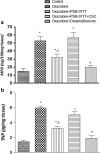Anti-inflammatory effect of a novel locally acting A2A receptor agonist in a rat model of oxazolone-induced colitis
- PMID: 29116551
- PMCID: PMC5842152
- DOI: 10.1007/s11302-017-9591-2
Anti-inflammatory effect of a novel locally acting A2A receptor agonist in a rat model of oxazolone-induced colitis
Abstract
Adenosine represents a powerful modulating factor, which has been shown to orchestrate the scope, duration, and remission of the inflammatory response through the activation of four specific receptors, classified as A1, A2A, A2B, and A3, all being widely expressed in a variety of immune cells. Several selective A2A receptor agonists have displayed anti-inflammatory effects, through the suppression of IL-12, TNF, and IFN-γ production by monocytes and lymphocytes, in the setting of chronic intestinal inflammation. However, the therapeutic application of A2A receptor agonists remains hindered by the risk of serious cardiovascular adverse effects arising from the wide systemic distribution of A2A receptors. The present study focused on evaluating the anti-inflammatory effects of the novel poorly absorbed A2A receptor agonist PSB-0777 in a rat model of oxazolone-induced colitis as well as to evaluate its cardiovascular adverse effects, paying particular attention to the onset of hypotension, one of the main adverse effects associated with the systemic pharmacological activation of A2A receptors. Colitis was associated with decreased body weight, an enhanced microscopic damage score and increased levels of colonic myeloperoxidase (MPO). PSB-0777, but not dexamethasone, improved body weight. PSB-0777 and dexamethasone ameliorated microscopic indexes of inflammation and reduced MPO levels. The beneficial effects of PSB-0777 on inflammatory parameters were prevented by the pharmacological blockade of A2A receptors. No adverse cardiovascular events were observed upon PSB-0777 administration. The novel A2A receptor agonist PSB-0777 could represent the base for the development of innovative pharmacological entities able to act in an event-specific and site-specific manner.
Keywords: A2A adenosine receptor; Colitis; Colon; Inflammation; Locally acting agent.
Conflict of interest statement
Conflict of interest
Matteo Fornai declares that he has no conflict of interest.
Luca Antonioli declares that he has no conflict of interest.
Alì El-Tayeb declares that he has no conflict of interest.
Carolina Pellegrini declares that she has no conflict of interest.
Oriana Awwad declares that she has no conflict of interest.
Giulio Giustarini declares that he has no conflict of interest.
Gianfranco Natale declares that he has no conflict of interest.
Larisa Ryskalin declares that she has no conflict of interest.
Zoltan H Németh declares that he has no conflict of interest.
Christa E Müller declares that she has no conflict of interest.
Corrado Blandizzi declares that he has no conflict of interest.
Rocchina Colucci declares that he has no conflict of interest.
Figures







References
Publication types
MeSH terms
Substances
LinkOut - more resources
Full Text Sources
Other Literature Sources
Research Materials
Miscellaneous

